Catocala of Louisiana
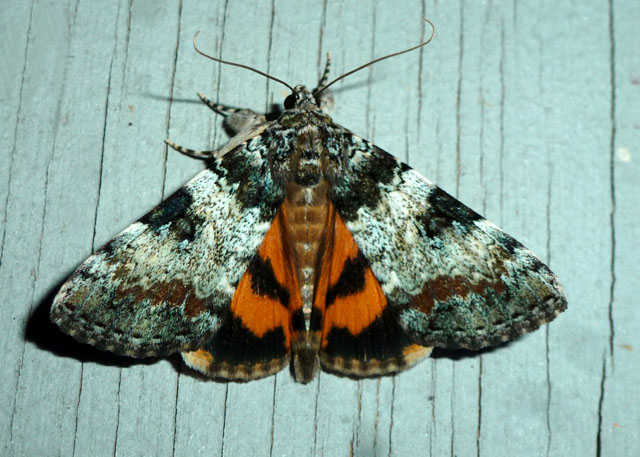
Catocala connubialis, Shreveport, Caddo Parish, Louisiana,
May 20, 2014, courtesy of Rosemary Seidler.
|
|
Updated as per "Systematics of moths in the genus Catocala (Lepidoptera, Erebidae) IV. Nomenclatorial stabilization of the Nearctic fauna, with a revised synonymic check list"; ZooKeys 39: 37–83 (2010) by Lawrence F. Gall, David C. Hawks; March 21, 2010 |

http://www.daltonstate.edu/galeps/list%20page%20folder/Noctuidae%20Erebidae.htm
Those species listed from Georgia to Texas or Arkansas have been included to comprise this list.
The list probably contains several omissions. It will be updated and refined as sighting data arrives over the years. Please send images with dates and collecting locales (including county) to Bill Oehlke.
I will soon update this list from an article by Vernon A. Brou. Vernon has provided many of the images that appear in the files of species from Louisiana
Many thanks to Jeff Trahan who provides images and data for many species, including this beautiful shot of Catocala ilia.
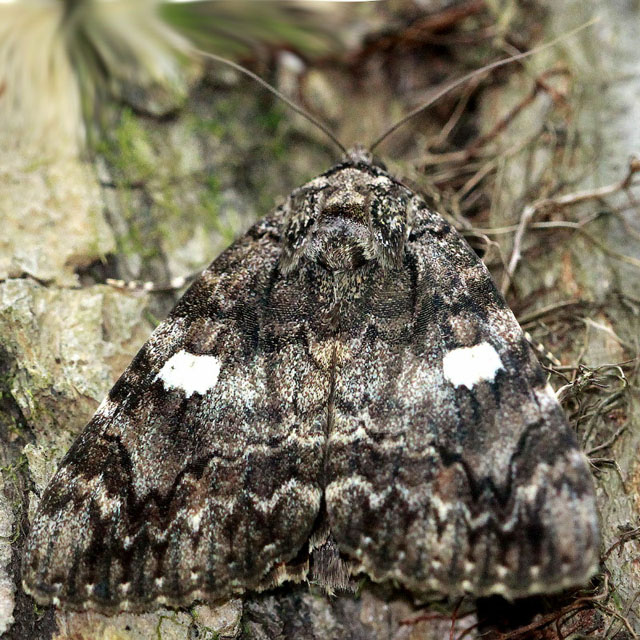
Catocala ilia form conspicua, Eddie Jones Park, Caddo Parish, Louisiana,
May 9, 2012, courtesy of Jeff Trahan.
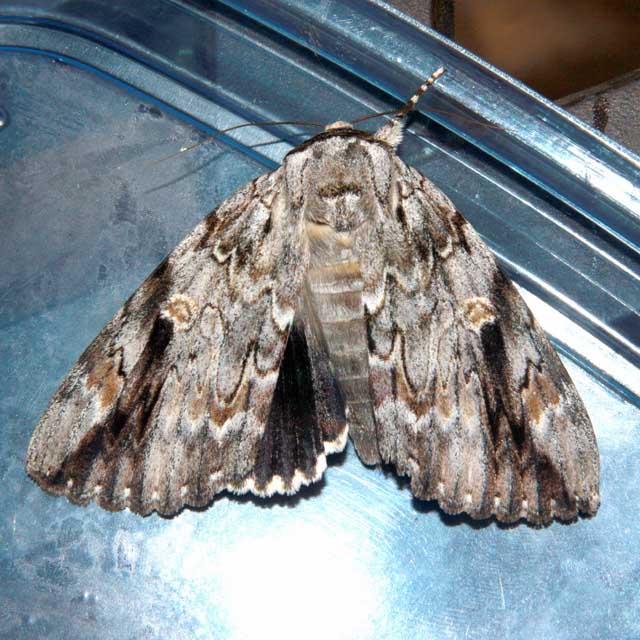
Catocala maestosa Shreveport, Caddo Parish, Louisiana,
August 1, 2013, courtesy of Jeff Trahan.
Visit Louisiana Sphingidae, Hawkmoths. Use your browser "Back" button to return to this page.
As of April 4, 2010, this page has been further updated as per research data compiled by Larry Gall and David Hawks.
I would like to continue to refine the listings to county levels so images and data (date, location at least to county level,
bait, lights) would be very much appreciated. Please send same to Bill Oehlke.
All images that I use on my websites remain the property of respective photographers and images are credited as such.
The Identification Keys Diagram should help you understand the terminology I have used in describing the various species.
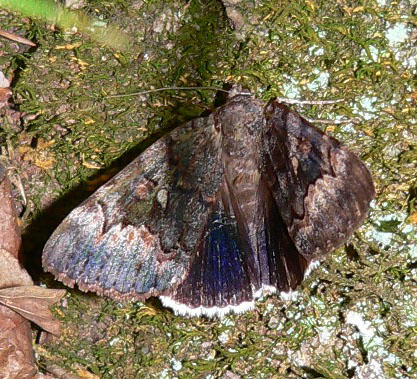
Catocala epione, Shreveport, Caddo Parish, Louisiana, courtesy of Rosemary Seidler.
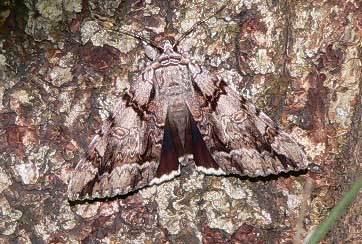
Catocala vidua, Shreveport, Caddo Parish, Louisiana, courtesy of Rosemary Seidler.
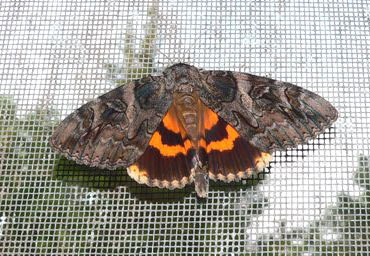
Catocala umbrosa, Shreveport, Caddo Parish, Louisiana,
courtesy of Rosemary Seidler, id correction by Vernon Brou.
Little Yellow-Orange Underwings: Wingspans: 35-45mm
Little Yellow-Orange Underwings: Wingspans: 35-56mm |
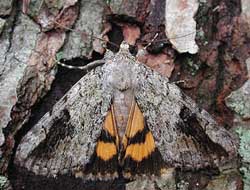
| ** 8876 Catocala micronympha, Little Nymph Underwing, (wingspan: 35-50mm). John Himmelman image. Usual specimens have grey forewings shaded with green, brown, black and white tints. Usually a darkened band passing from costa through reniform spot to outer margin. High variability. Common, widespread. May-June. |
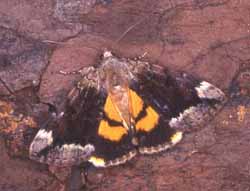
| ** 8876 Catocala micronympha form gisela, the Little Nymph Underwing, (wingspan: 35-50mm). Usually specimens have grey forewings shaded with green, brown, black, white tints. Usually a darkened band passing from costa through the reniform spot to outer margin. Form "gisela" Meyer has a forewing that is mostly black. Leroy Simon image. |
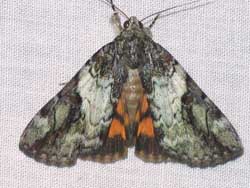
| ** 8876 Catocala micronympha form hero, Little Nymph Underwing, (wingspan: 35-50mm). Usually specimens have grey forewings shaded with green, brown, black and white tints. There is usually a darkened band passing from the costa through the reniform spot to the outer margin. Form "hero" H. Edwards has a median area that is mostly white. Joe Garris image. |
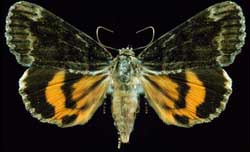
| ** 8876 Catocala micronympha
form lolita,
Little Nymph Underwing, (wingspan: 35-50mm).
Form "lolita" Sargent has very dark forewings. |
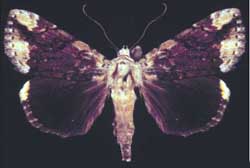
| ** 8876 Catocala micronympha form sargenti, the Little Nymph Underwing, (wingspan: 35-50mm). Usual specimens have grey forewings shaded with green, brown, black and white tints. Usually a darkened band passing from costa through reniform spot to outer margin. Form "sargenti" Covell (very rare) has a hindwing that is all black. |
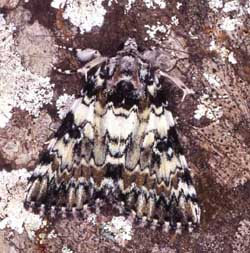
| ** 8877 connubialis, Connubial Underwing, (wingspan: 35-50mm). Fw highly variable; several different forms: "sancta"; typical form, forewings with white ground colour and sharply contrasting black lines and markings. Brown shading between post medial and subterminal lines; "cordelia": coloured as above but markings are faint; "pulverulenta": grey-green forewings with faint markings, sometimes none; "broweri": melanic form with fws dark green, almost black. Hw has separate anal spot and outer band ends with straight cut. Leroy Simon image. |
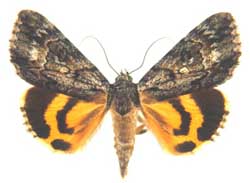
| ** 8848 bastropi, Bastroph Underwing, (wingspan: 40mm). There is a distinct white "smile" (in spread specimens) between the reniform and subreniform spots. There is also a narrow but distinct white line immediately following the black postmedial line. Hw deep yellow orange, outer black band interrupted, followed by dot, ending before im. replaces (2017) louiseae in Louisiana |
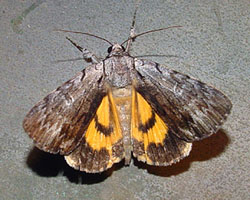
| ** 8772 gracilis; Graceful Underwing, wingspan 40-45mm.Gracilis closely resembles sordida but the hindwing loop is not complete in gracilis as it is in sordida. Gracilis also tends to have a darker inner margin and there is frequently (99% of the time, Dale Schweitzer, via Joe Garris), but not always, a basal dash. Sordida never has the basal dash. |
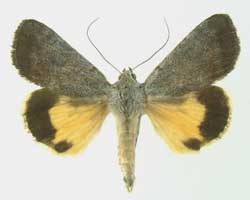
| ** 8845 messalina, Messalina Underwing, (wingspan: 40-45mm).The forewing is a plain, dull, grey-green, darkening toward the outer margin. The hindwing is like that of the false underwing, having no inner black band. The outer band is quite wide. |
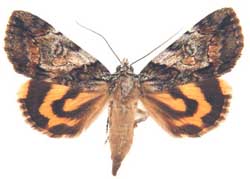
| Catocala pretiosa texarkana
Texas-Arkansas Underwing; 40-50mm;
The median area is quite light with a wide whitish band paralleling the antemedial line from the costa almost to the
inner margin. The subreniform spot is distinctly brown. |
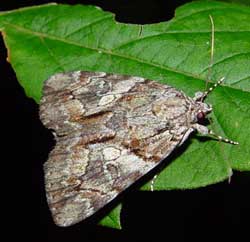
| Catocala mira; Wonderful Underwing, wingspan: 40-50mm. Pale basal area of fw distinguishes mira from blandula (dark brown) and crataegi (black). Fw lacks dark contrasting lines of crataegi and blandula. Considerable brown in subterminal area and subreniform spot very conspicuous, usually brown. Light area runs obliquely from costa to subreniform spot. Noticeable space along i. m. between antemedial and postmedial lines. Hw deep orange and has a complete inner black band. The outer black band is unbroken Tim Dyson image. |
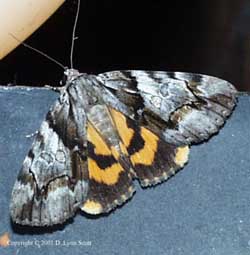
| ** 8867 Catocala blandula;
Charming Underwing, wingspan: 40-50mm. |
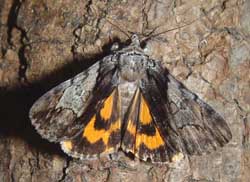
| ** 8858 Catocala crataegi; as subspecies 1; Hawthorn Underwing, wingspan: 40-50mm Determination is based on dark (black) shading in forewing basal area continuing along inner margin to anal angle and brown shading beyond postmedial line. Definite greenish cast to median area. Lower wing has outer black band, broken near anal angle, distinguishing crataegi from blandula. |
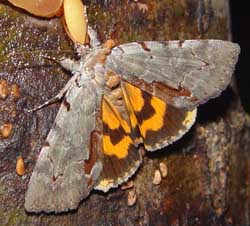
| ** 8864 Catocala grynea ; Woody Underwing, 40-50mm:
The forewing is a dull greenish grey with orangey-brown shading along
the inner margin. The antemedial, median and postmedial lines are
quite faint.
Praeclara is somewhat similar but has a break in the brown shading
between the am and pm lines. Praeclara also has a paler orange
hindwing color. |
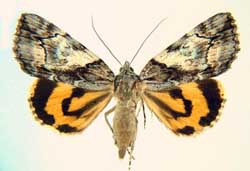
| Catocala pretiosa Precious Underwing; 40-50mm; This species is quite similar to crataegi and mira, but pretiosa has considerable creamy white colouration in the median area. The lower portion of the basal area is also light, not dark as in crataegi. The inner black band of the hindwing forms a loop and the outer band is broken (not complete as in mira, followed by a dot that tapers to the anal angle. |
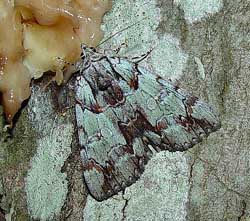
| ** 8865 praeclara; Praeclara Underwing, wingspan: 40-50mm. Fw pale greenish-grey with considerable contrasting brown shading beyond post medial line. There is a black basal dash very close to the inner margin and another dash, higher up in the median area. Note the contrasting shapes of the reniform and subreniform spots. Upper of two larger pml teeth is longer, wider than lower tooth. Note double, white filled amls. Lighter, subcircular patch, outlined in black, brown on lower thorax. |
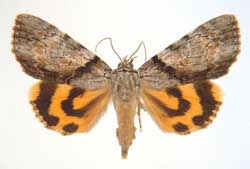
| ** 8860 lincolnana, Underwing, (wingspan: 40-50mm). Fws pale grey-brown with distinct dark curve running from costa along antemedial line to im, advancing to anal angle. Hw inner black band forms complete loop, outer black band broken and followed by dot. Rare, seems to prefer bait to lights. |
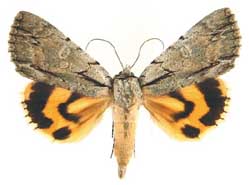
| ** 8772 clintoni; Clinton's Underwing, wingspan 45-55mm.The black basal dash distinguishes clintoni from illecta and abbreviatella, both of which lack the dash. Vernon Brou image. April-June, peak first week of May. |
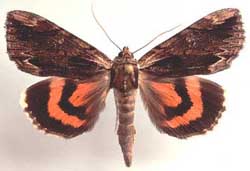
| ** 8857 Catocala ultronia; Ultronia Underwing, wingspan: 50-63mm.Fws typically gray-brown, with a distinct and very dark inner margin and characteristic light brown patch, underscored by very dark arc, near wingtip. Underwings can be yellow to orange to salmon. |
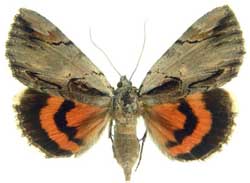
| ** 8857 Catocala ultronia form lucinda; Ultronia Underwing, wingspan: 50-63mm.In form lucinda most of the forewing is bright grey. On all forms there is
extensive orange-salmon colouration on hw ventral surface,
and there is a dark discal lunule. |
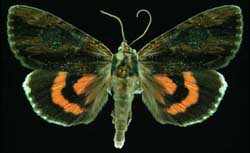
| Catocala ultronia, form nigrescens, the Ultronia Underwing, wingspan: 50-63mm. In the melanic form nigrescens, the dorsal forewing is very dark. Even darker subapical arc, basal dash and dash near anal angle are still visible. Dark basal hairs on hindwing. Harold J. Vermes slide, used with permission from his son. |
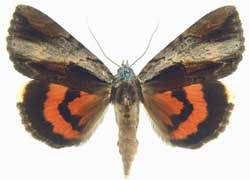
| Catocala ultronia form celia.
In form celia there is a wide, light grey band separating a dark region along inner margin and
a dark patch near the apex.
The ventral surface of forewings of all forms has a generous suffusion
of orange-salmon scales in the lower half of the median area. |
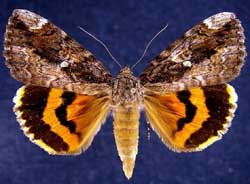
| ** 8770 Catocala innubens; Betrothed; 55-72mm. Forewing is mottled with white, grey and brown, and subrenifrom spot tends to be lighter in colour, although it is sometimes obscured by an indistinct blackish bar which runs from middle of basal/thorax connection to just below much lighter apex at outer margin.Jim Vargo image. |
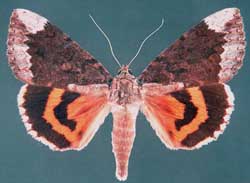
| ** 8770 Catocala innubens form scintillans; Betrothed; 55-72mm.In form scintillans most of the basal area (all but lower third) and all of the median area of the forewing is dark reddish brown. The area outside the pm line is grey. Vernon A Brou image. |
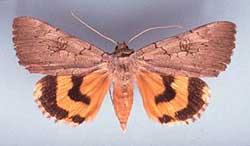
| ** 8840
Catocala illecta;
Magdalen Underwing, 60-70mm;
The forewing pattern and colouration is much like that of concumbens,
pale grey with faint black lines. |
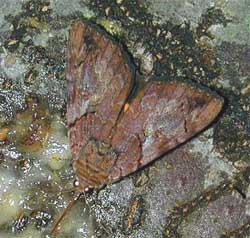
| Catocala muliercula; Little Wife Underwing; Dark, distinct upper half am line runs obliquely toward anal angle, turns in two lobes to im; basal area dark brown; inner brown kidney shaped reniform spot, oulined in black then light then black again; open, lighter subreniform spot with light area from it to costa; median area greyish-blue-brown; subterminal area brown; terminal area greyish-blue-brown; lighter patch at apex. Hw dark bands thick, much dark scaling in basal area covering 2/3, joining inner black band to im. |
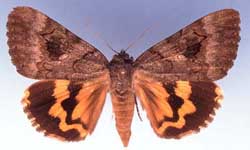
| ** 8772 Catocala consors WO; Consort, wingspan: 70mm plus. Fw with irregular am and pm narrow black lines. Dark patch outside the reniform and subreniform spots. The orange-yellow hindwing pm band tends to be narrow and irregularly zigzagged. Sometimes the band is wider and slightly less irregular. James K. Adams image. |
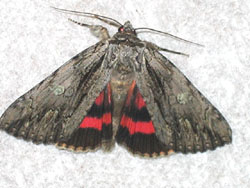
| ** 8851 Catocala coccinata; Scarlet; 57-70mm: Usually diffuse basal, anal dashes on otherwise light grey, mottled fw. Hw fringe white (often with some salmon scaling), heavily checked. "Tooth" just below pair of very elongated "teeth" is much reduced, quite rounded, usually allowing considerable room for lighter patch of scales. Dark bar crosses thorax. Reniform spot light, often with greenish cast. Joe Garris image. |
Solid Black Underwings: Smallest to Largest, Similar Species Paired
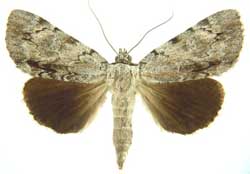
| miranda, Miranda Underwing; 37-45mm; Fw: plain pale grey with very light and fine black lines, darker and wider near costa. Hw black with white fringe at the apex, turning to grey along the outer margin. Miranda is smaller than look-alike orba and miranda also has a dark bar just above the inner margin in the median area, projecting toward the anal angle. May 20-June 7; St. Tammany, rare |
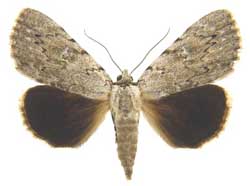
| Catocala orba, Orba Underwing, (wingspan: 40-45mm). Fw uniform grey with light lines and poorly defined spots. Hw underside completely black. Hw fringe unbroken, slightly off white, somewhat grey. Peaks mid May. |
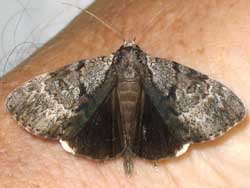
| Catocala andromedae, Gloomy Underwing, (wingspan: 40-50mm). Black underwings and dark grey fringe of hws, coupled with dark i.m. of fws help to identify this species. There is also a very dark "flying saucer" shape, adjoining subreniform spot to midpoint of am line. The "teeth" of pm line short and blunt, outwardly edged with white. Subterminal line is also outwardly edged with white. |
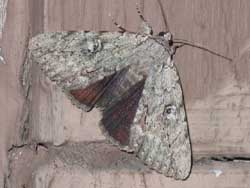
| ** 8781 judith, Judith's Underwing, 45-55mm; one of smaller "black" underwings. Fw uniform light grey with thin, only slightly darkened antemedial, median & pm lines. No darkened dashes (slight anal dash) or transverse lines. Reniform area slightly darkened while the area just before the subterminal line is a bit lighter. Note absence of hw white fringe. Joe Garris photo. May 31-June 1, rare in LA. |
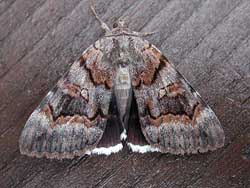
| ** 8773
Catocala epione , yes;
Epione Underwing, wingspan: 55-65mmJohn Himmelman image. |
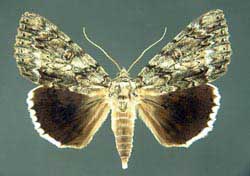
| Catocala ulalume, Ulalume Underwing, (wingspan: 65mm). Fw mottled light to dark grey, no strongly contrasting lines, dashes, bars. Aml ends at im in very light coloured crescent, close to pml. Open subrenifrom spot light coloured, "comma" shaped with triangular, somewhat bulbous head. Aml: short, thin, slightly humped dark line through midpoint. Hw black, fringe pure white, thin, pointed checking. |
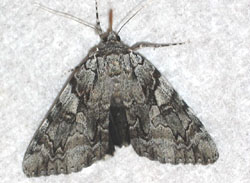
| Catocala dejecta; Dejected; wingspan 56-73mm. Pale grey patch from reniform and subreniform juncture to costal margin is diagnostic. Note open, light "pork chop" shape of subreniform spot. Two "teeth" in pml above subreniform spot are relatively short and blunt. Upper portion of aml thick and black; lower half has light rounded lobes outlined in black. Hw fringe is white with black wing veins extending like "teeth". |
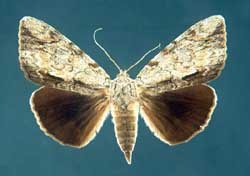
| ** 8791
Catocala insolabilis;
Inconsolable, wingspan: 65-75mm;
Fw light grey with blackish shading along inner
margin. Am and pm lines: thin.
Hw fringe very narrow and grey, becoming whiter toward
apex.
Ventral surface clearly distinguishes insolabis, being almost
completely black except for some white in basal area. |
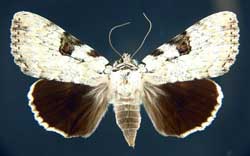
| Catocala sappho, Underwing, (wingspan: 62-75mm), Forewings are off white with some grey-black-brown peppering and yellow-beige lines. The reniform spot is brown and the subreniform spot is almost pure white; the hindwings are black with a white fringe. |
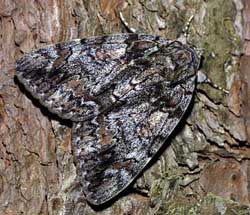
| ** 8794 Catocala lacrymosa; Tearful Underwing, 60-82mm. The forewing is highly variable with a mixture of black, brown (wing tips and outside postmedial line) and dark grey scaling. There are usually whitish crescents, along the inner margin at the base of the antemedial and postmedial lines. The hindwings are black with white checkered fringe, turning black near the anal angle. There are several different forms. |
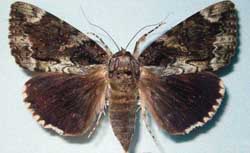
| ** 8794
Catocala lacrymosa;
Tearful Underwing, 60-82mm.
Form paulina: lighter grey post median area & area along and parallel to inner margin, in sharp contrast to
darker basal median areas. |
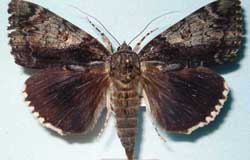
| ** 8794
Catocala lacrymosa;
Tearful Underwing, 60-82mm. |
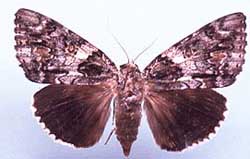
| ** 8794
Catocala lacrymosa;
Tearful Underwing, 60-82mm.
In form albomarginata there is an abundance of white scaling on the forewing. |
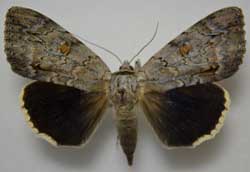
| ** Catocala myristica; slightly smaller than robinsonii, myristica has a browner cell spot and a darker bottom line on the longest extension of the pm line near the inner margin. Probably only in Black Belt on nutmeg hickory. unconfirmed |
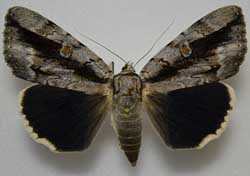
| ** Catocala myristica; slightly smaller than robinsonii, myristica has a browner cell spot and a darker bottom line on the longest extension of the pm line near the inner margin. Dark bar very prominent but does not intrude on cell mark, nor present along inner edge of reniform spot. Also note absence of upper black line inside reniform spot. unconfirmed |
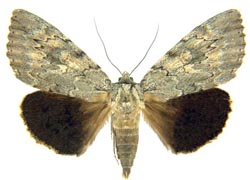
| ** 8780 Catocala robinsonii; 70-80mm. Fws relatively plain pale grey. Female has basal dash, absent in male. Currata French, 1882, female form: weak basal dash. Rare form missouriensis Schwarz, 1915: dark, broad bar extending from basal area to o.m. just below apex. Lighter grey rnfm, subrnfm spots break bar in missouriensis, found from PA. to FL. Hw fringe: White; bands on ventral surface prominent. |
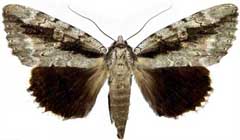
| ** 8780 Catocala robinsonii; 70-80mm. Barred form very similar to Catocala myristica but note very thin pm line from costa to inner margin. In myristica line thickens along lower edge of longest "loop" near inner margin. Note presence of upper black line inside reniform spot. |
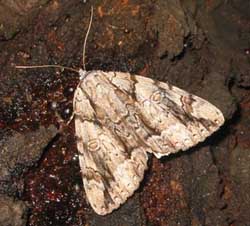
| ** 8792 Catocala vidua, yes; Widow; wingspan: 70-80mm. Fw light grey. Dark arc runs through top of reniform spot to just below apex. Heavy, dark anal, basal dashes, connecting to dark median bar, running parallel to i.m.. Am line thick, black in upper half. Reniform spot: two almost concentric irregular ovals. Subreniform spot light, open, constricted as it meets pm line. Hw black with broad, white fringe, only lightly interrupted. |
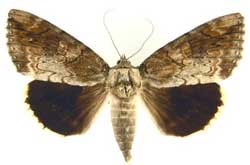
| Catocala atocala, Underwing, (wingspan: approximately 70-75mm). Similar to agrippina, but reniform is more clearly defined in atocala. Closed subreniform of atocala may be open or closed in agrippina. Distinct basal dash of agrippina females is nearly absent in atocala females. Hw undersurface white areas on agrippina are beige on atocala. Hw bulge (discal spot) on atocala, is not present on agrippina. |
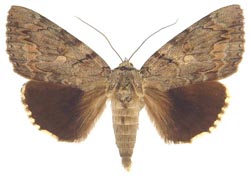
| Catocala agrippina 75-85mm; Male fws: grey-black with some reddish brown (distinguishing characteristic); am and pm lines: black, darker toward costa, much lighter near inner margin. Reniform: indistinct, brown; sub-reniform: almost obsolete, but lighter than surrounding areas. Hws: black, with greyish hairs at base and im. Fringe: white, only partly cut with black at vein terminations. |
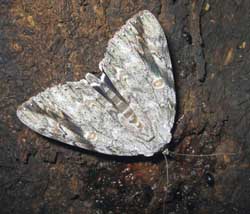
| ** 8793 Catocala maestosa, Sad Underwing, wingspan: 78-98mm. Similar to, but usually larger than, vidua. Both have dark arc from costa, above reniform spot, to outer margin just below apex. Maesotsa, however, lacks dark bar, found on vidua, parallel to inner margin. Reniform spot is brown and there is brown shading just outside the postmedial line. Hindwing fringe is white, narrow and heavily barred. |
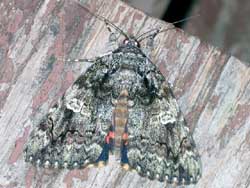
| ** 8801 Catocala ilia; Ilia; wingspan: 65-82mm. Several different forms, most have characteristic white area in and around reniform spot. Diffuse dark arc running from this spot to just below apex. Subreniform spot squarish, concave inner and outer edges and elongated constriction connecting it to pml. White dots near fw om in character with the overall "contrasting" appearance. |
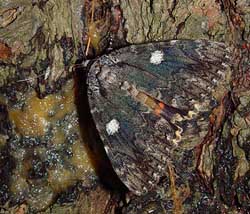
| ** 8801 Catocala ilia; Ilia; form conspicuaIn this form the entire reniform spot is heavily suffused with white scaling on an otherwise darker ground colour. Hence the form name "conspicua". Tim Dyson image. |
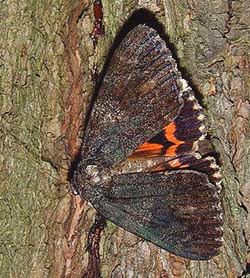
| ** 8801 Catocala ilia; Ilia; form satanasIn this melanic form the entire forewing, including the reniform spot is very dark. Hence the form name "satanas". The dark basal streak is still evident on this form. Tim Dyson image. |
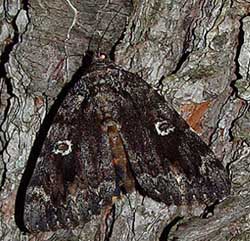
| ** 8801 Catocala ilia; Ilia; form normaniIn this semi-melanic form the entire forewing, excluding the reniform spot, is relatively dark. The brownish, kidney-shaped center of the reniform spot is outlined in white. The basal streak and subapical arc are still visible. Tim Dyson image. |
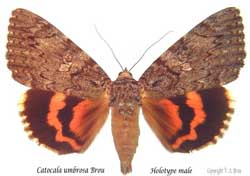
| ** 8857.1 Catocala umbrosa; mm; Double brown am line, inward line fainter, filled with off white; reniform spot brown center outlined in black , off white and black again; subreniform, large, pale brown, closed. Pm line wit htwo elongated upper teeth, next tooth reduced, next two progressively longer, rounded, final lobe rounded and shorter. HW with dark scaling/hairs in basal median area along im |
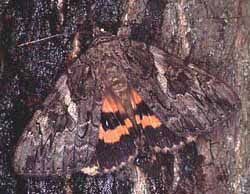
| ** 8771 Catocala piatrix ; Penitent, wingspan: 68-84mm. Fw: light-colored band/bar extending from light coloured, triangular subreniform spot along am line to costa. Brown, kidney-shaped reniform spot surrounded in pale grey, outlined in black, usually with distinct black along wing veins in a dark area outside the reniform spot. Hw: fringe lightly barred; lighter in color than deeper orange on rest of wing. |
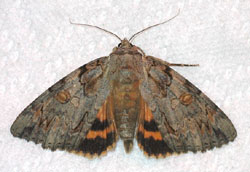
| ** 8798 Catocala neogama; wingspan 70-85mm. Brown head, thorax, larger size as compared to C. palaeogama. Neogama tend to be slightly smaller than subnata, have darker grey brown fws with more pronounced markings. Examination of hind tibia needed for id. Neogama's: flattened, unevenly, sparsely spined; subnata's: cylindrical, spines dense, uniform in distribution. Joe Garris photo. |
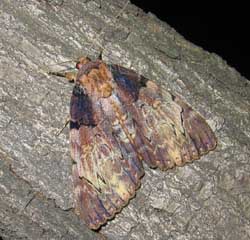
| Catocala nebulosa; 75-86mm; Moths have prominent dark brown upper-half-basal patch that extends to and ends at antemedial line. Apical area also tends to be brown, much darker than median area but not as dark as basal patch. The anal angle also has the darker brown scaling. The pm line is distinct near costa and inner margin, but becomes weak between the two. It meets inner margin in relative close proximity to am line. Closed subreniform spot is large and connects to the pm line via a thin line. |
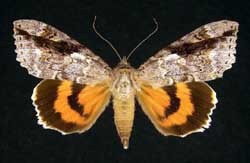
|
** 8804 C. marmorata;
Marbled; wingspan 85-95mm |
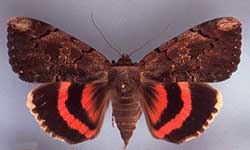
| ** Catocala carissima; wingspan 70-85mm. Distinct light grey brown area at fw apex, preceded just inside pm line by slightly darker patch. Am and pm lines sharp and dark. Hw inner black band wide, complete, merges with extensive grey-black scaling along im. Hw fringe cream coloured. |
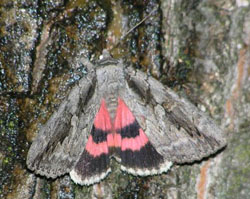
|
** 8834 amatrix Sweetheart Underwing; (wingspan 75-95mm). Very skittish, frequently hides in caves, under bridges, under tree bark, etc. by day, resting with head down. Hw patterning and colouration similar to that of C. concumbens, but large size (wingspan 75-95mm) and dark bar running from basal area to just below apex distinguishes C. amatrix. See large Catocala amatrix courtesy of Joan F. Rickert. |
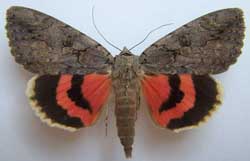
|
** 8834 amatrix form selecta
Sweetheart Underwing; (wingspan 75-95mm) |
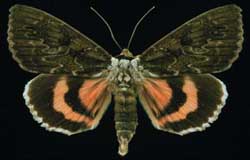
|
** 8834 amatrix form hesseli
Sweetheart Underwing; (wingspan 75-95mm) |
|

|